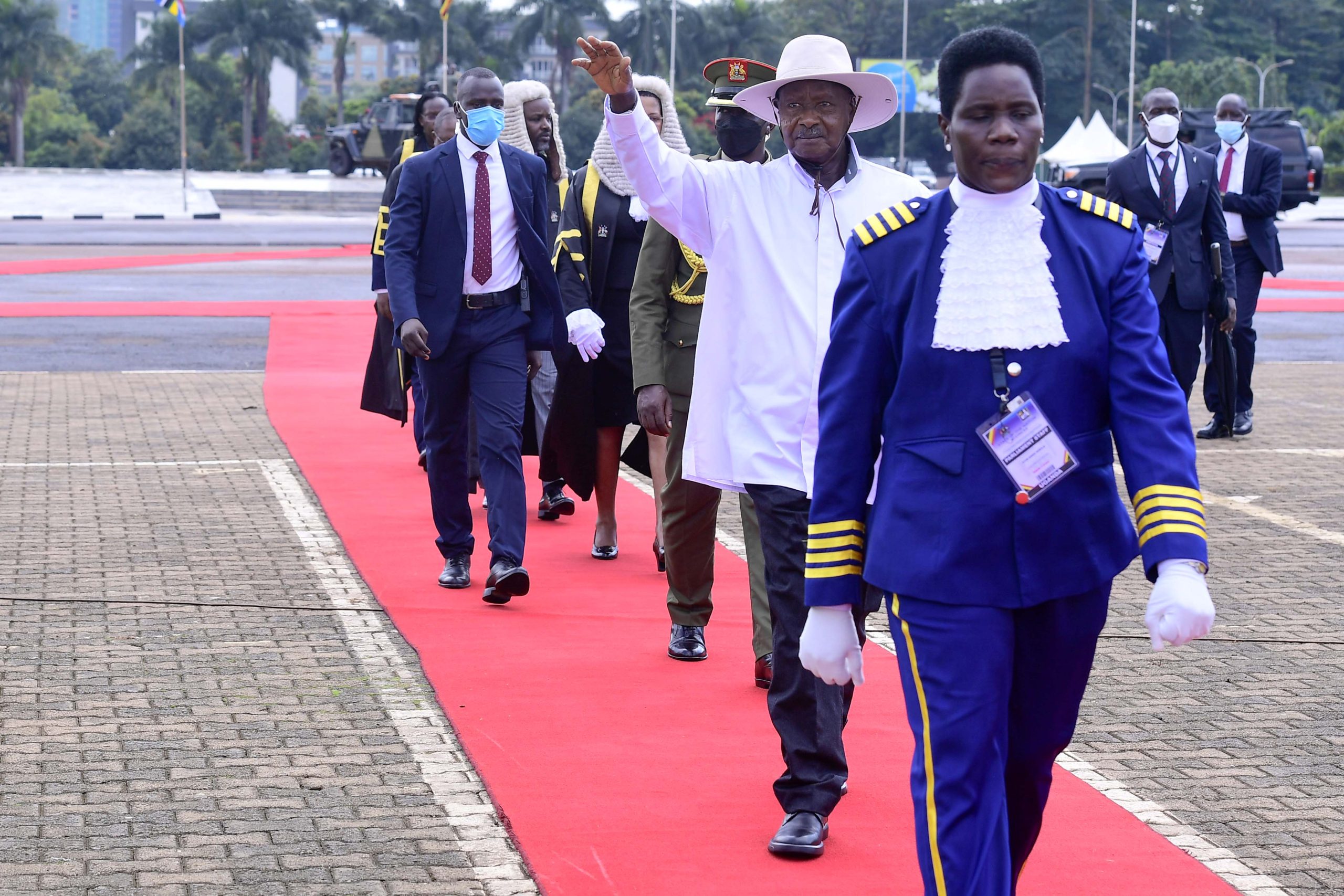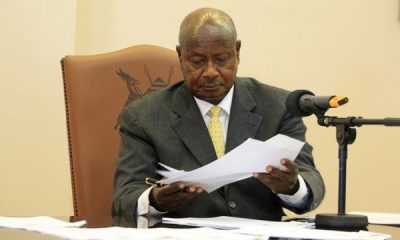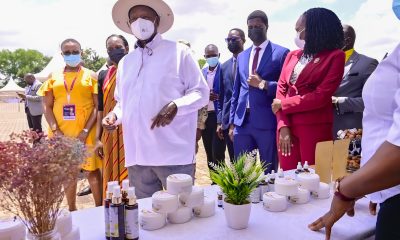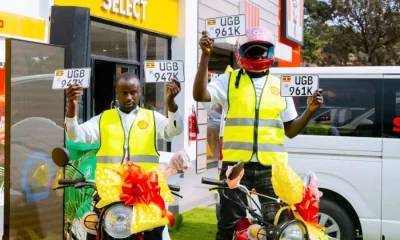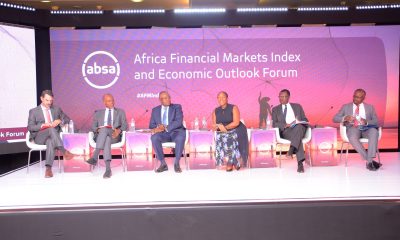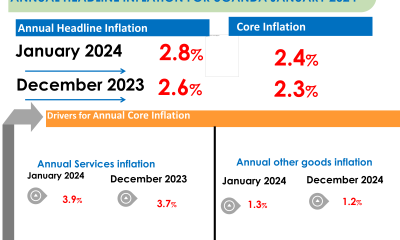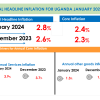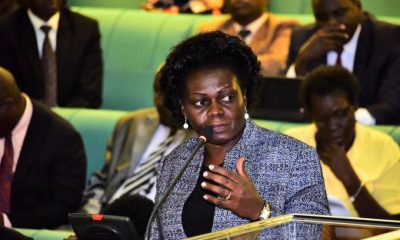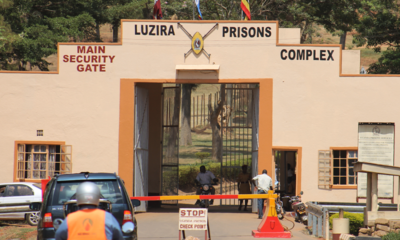Museveni outlines economic priorities of Government in 2023/24

1. PERFORMANCE OF THE ECONOMY
Economic Growth
As a result of the NRM Government’s deliberate efforts to expand the economic base of the Country, a strong foundation has been built for rapid economic growth and socio-economic transformation. In 1986, when the NRM Government took administration of the Country, the size of our economy was equivalent to US$ 1.5 billion. Today, our economy is about US$ 49.4billion. In other words, the economy has expanded by more than 30 times since 1986.
The economic growth for this year is projected at 5.5 percent in real terms compared to 4.7 percent last financial year 2021/22. Over the next five years, the economy is projected to grow at an average of 6.5-7.0 percent per year. But these are growth rates of the Ministry of Finance but me I believe we can grow much faster. This growth will arise from:
- Economic stability as a result of low inflation;
- Establishment of more manufacturing plants;
- Continued implementation of the PDM;
- Support to Small and Medium-Scale Enterprises through Emyooga SACCOs, the Youth and Women funds and other initiatives;
- Increased Oil and Gas Sector activities; and
- Growth in regional trade and the positive impact of the continued recovery of economies in the Middle East, Asia, Europe and USA which provide markets for our exports.
Therefore, by the end of FY 2023/24, Uganda’s GDP is projected to grow up to UShs.207.22 trillion (equivalent to USD 55.17 billion), translating to USD 156.76billion in PPP terms. This in turn is projected to grow our GDP per capita to USD 1,186, up from USD 1,096 in FY 2022/23.
Inflation
The prices of domestic goods and services have come down compared to what they were one year ago. To take a few examples, the price of edible oil has reduced from UShs. 10,079 per litre in March, 2022 to UShs. 9,556 per litre in March, 2023; Petrol from a peak of UShs. 6,563 a litre to UShs. 5,138 a litre now, ordinary cement from a peak of UShs. 37,315 a bag of 50 kg in May, 2022 to now UShs.34,874.
Therefore, we have defeated the rapid increase in prices of both consumer and production prices. However, food prices remain high due to climate change effects that caused prolonged drought in many parts of the Country. This will be history because of the on-going Government investment in small- scale solar powered irrigation to address water shortages.
Government resisted price controls and subsidies when prices went up sharply. This is because these kinds of measures are not sustainable and they instead introduce distortions in the economy. They bring about the old habits of smuggling (magendo) and can result in shortages of goods in the markets. This happens when some rich business people hide consumer goods to cause artificial shortages in order to benefit from higher prices. Some countries gave subsidies or controlled prices of some essential commodities such as fuel, bread, wheat, etc. We do not believe in subsidizing consumption such as subsidizing petrol for people to drive to night clubs.
However, if prices are distorted by some non-economic factors such as sanctions by the West on account of the war between Russia and Ukraine, for inputs into production such as fertilizers, it may be logical to look at subsidies. We are studying this. Our policy, as Government, is to allow demand and supply forces to determine prices and incentivize production.
However on the issue of fertilizers we shall either get a solution to stop the west from interfering with the prices of the fertilizers or we subsidize.
International Trade
Export revenue of goods and services was US$ 6.0484 billion for the calendar year ending 2022, of which export of goods merchandise was worth US$ 4.272 billion. For the 12 months to February, 2023, we exported 5.7 million bags each of 50kg of coffee worth US$ 858.7 million, fish was US$ 166.9 million, beans US$132.8 million, sugar US$ 146.8 million, maize US$ 131.2 million and industrial products worth US$ 348.9 million were exported mainly to regional markets. All this has been possible because of the NRM Government’s efforts to grow and diversify the economy. Export of services was worth US$ 1.776 billion of which tourism was US$ 1.047 billion, equivalent to 59 percent of all the services export receipts. This shows the huge untapped potential in the tourism sector that Government is working, in partnership with the private sector, to harness.
Regional integration efforts and promoting intra-Africa trade, are taking root. Uganda now exports more to Africa than to the rest of the world, with 86 percent of our exports (US$3.8 billion) to Africa in the 12 months to February, 2023 and 57 percent (US$2.5 billion) to the six (6) EAC countries. What we need to intensify as Africa, is to build regional infrastructure to improve connectivity within the region and reduce trade transaction costs. This way, we shall be able to pull our populations out of poverty much faster because we shall attract more investments.
Foreign Direct Investment
Uganda’s investment climate remains competitive in the region and globally. Because of this, investors willing to bring their money and invest here, have increased. This is partly due to the stable and sound economic policies and the prevailing peace and security in the Country. Foreign Direct Investment (FDI) inflows to Uganda, continued to recover and reached US$ 945 million during the first six(6) months of this financial year 2022/23. This is, in part, due to increased financing to the Oil and Gas, as well as the Mineral Development Sectors.
Increase in Household Incomes
Although the Country has been faced with economic shocks, household businesses, have responded positively to Government investment in especially infrastructure and the various wealth creation initiatives. As a result, 60 percent of households have increased their incomes in the year ending December, 2022, compared to 43 percent whose incomes increased in the same period a year ago. This means that the Government’s effort to create wealth at household level, is taking root. This will be further enhanced by the Parish Development Model and Emyooga Government initiatives. As prices stabilised towards end of 2022 and incomes increased, access and affordability of essential goods and food products, has improved. The prices of fuel, sugar, maize flour, beans, cooking oil and eggs, have all reduced since their peak between August and December of 2022.
An Expanded and Diversified Economic Base
When the NRM Government took over in 1986, the economy depended on a few cash crops namely: coffee, cotton, tea and tobacco. Since then, the economy has become bigger and diversified. Some of the agricultural produce which were only for consumption at home such as maize, beans, matooke, fish, milk, etc., have become commercial, contributing to household incomes. Other crops that have joined the traditional cash crops include: sunflower, from which we now make edible oil, palm oil trees, vanilla, avocado, oranges and mangoes, which are raw materials for the agro-processing plants.
We now produce enough sugar (in fact we now have surplus sugar which we are exporting to our neighbours), steel products, cement, other building materials such as tiles at Kapeeka Industrial Park, mineral extraction and beneficiation, etc. We shall soon produce oil and gas and the infrastructure development to enable this is currently under construction, including the EACOP, power and water infrastructure and Kabaale International Airport. Uganda has a vibrant economy and workforce, that is transforming our economy into a digital one. There are many businesses and financial transactions taking place within the Country, using the internet and other online avenues. This is not only improving efficiency, but also creating many jobs for the youth.
Fiscal Performance
Domestic revenue in financial year 2022/23, is estimated at UShs. 25.55 trillion. This is about 13.7 percent GDP. Next financial year 2023/24, we plan to collect UShs. 29.67 trillion as domestic revenue. Through our strategy to raise revenue, the Government is planning to raise at least 18 percent of GDP in the next five years.
When we achieve this target, we shall be able to reduce our reliance on borrowing to finance a larger share of our budget. We must avoid this problem of not being able to pay our debt by increasing what we collect from taxes and other sources of domestic revenue such as loyalties from our mineral development. Some countries are paying more than 50% of their collections in taxes to service debts. We should avoid falling into this debt trap. Therefore, in addition to collecting more revenue domestically, we should also not spend what we do not have. To achieve this, Government decided to rationalize Government departments to reduce duplications and wastage of taxpayer’s money and the Ministry of Public Service is finalizing the implementation plan for this decision.
2. INDUSTRIALIZATION
Our industrialization drive is bearing fruit, with many factories being set up. We have eight Government owned industrial parks which are currently operational. These include: Kampala Industrial and Business Park at Namanve with 125 companies operational, 144 companies under the construction stage and 106 companies at the planning stage, giving a total of 375 factories or companies; Luzira with 11companies operational; Bweyogerere with 8 companies; Soroti with 2 companies operational and 5 companies at the construction stage; Tian Shan Mbale Park with 16 companies which are operational while 4 are under construction stage; Jinja with one (1) company for assembling electric buses operational; Mbarara for small scale enterprises (SMEs) for which 35 workspaces are occupied; and Kasese where one (1) company is operational and 5 are under the construction stage. Both Karamoja and Koboko Industrial parks, will soon start. In addition, we have three(3) industrial parks which are operational under a Public-Private Partnership (PPP) arrangement.
These include: Liaoshen Kapeeka with 17 companies; MMP Buikwe with 6 companies operational; and Tian Tang Mukono with 4 companies. The total capital investment within the industrial parks so far is US$ 2.93 billion and 98,263 direct jobs created with many more indirect jobs. In total, 226 factories are operating within the industrial parks while 303 factories are either under construction or the planning stage. The development of industrial parks is one of the vehicles for socio-economic transformation, with the projected creation of 2.5 million jobs in the next five years. The factories in the Industrial Parks, do not include the stand-alone- factories owned and operated by many different investors. These are factories that belong to the Mukwano and Mulwana Group, etc. These are a total of 354 factories employing an additional 101,000 people. The total number of factories in Uganda is 4,008, with a total number of employees of 150,685.
3. THE PARISH DEVELOPMENT MODEL
We are committed to creating wealth and jobs by moving households from the non-money economy to the money economy. To achieve this goal, Government launched the Parish Development Model to accelerate socio-economic transformation. Using this approach, 39% households which are currently in the non-money economy (the majority of whom are in subsistence agriculture), will move into the money economy. The Parish Development Model will increase incomes, improve quality of life and eradicate poverty at household level through modernisation of agriculture, industrialisation, improved services delivery and using modern communication technologies.
Through the Parish Development Model, agriculture will be transformed from subsistence to commercial. This approach will organize and deliver Public and Private Sector interventions for wealth creation and employment generation, using the Parish as the economic unit for planning, budgeting and service delivery. Therefore, the 10,594 Parishes in the Country, will be the growth and service delivery units in the Parish Development Model. Government has committed UShs. 1,059 Billion this financial year, for its rollout countrywide. So far, Parishes which established SACCOs have received UShs. 50 million each, benefiting 906 SACCOs and more than 21,082 individual beneficiaries. Government will deepen the implementation of the Parish Development Model (PDM), beyond the Financial Inclusion pillar by maintaining disbursement of UShs. 100 million per parish next financial year and in the subsequent years.
When I visited some parts of the country, I was told that some of the Parish Development Model money, has been given to people who are not eligible. This includes politicians and public servants. I was also informed about the delays in accessing the funds released by the Ministry of Finance to the target beneficiaries. In some cases, a few elite people come together and form SACCOS and take all the funds released for the entire Parish. The State House Anti-Corruption Unit has arrested a number of culprits in the Acholi Zone where I started my up-country inspection trips. And I’m coming to all the other zones so thieves be on alert. I have also been to Masaka and I found there some prison candidates.
The PDM programme is a successor programme to the NAADS and OWC programmes. Especially the OWC programme, starting in 2013, succeeded in bringing down the households outside the money economy from 68% to the present figure of 39%.
The OWC did not only convert 29% of the households from abakolera ekidda kyonka (tic me ic keken) to the money economy, but, as an example, increased the production of coffee from 2million 60kg bags, to now 9million and would have increased to 12 million bags, if it was not for the change to the new model of PDM, which people are still acclimatizing to. The change was, however, necessary so that the program is beneficiaries-owned and we eliminate the grumblings of begabila bbokka (the government officials only serve themselves- or favour themselves).
PDM is saying; “Do it yourself; here is a grant from the government to your parish SACCO of UShs.100million, per year. Besides, the parish is near your home. Hence, no more excuses”.
This is the strategy of PDM, the money is there, cheap and the Parish is near. Therefore no more excuses by the people who want to remain in poverty.
4. EMYOOGA
About 3 years ago, I launched a wealth and jobs creation initiative for those who found it difficult to access financing through banks and other lenders for non-agricultural enterprises. This initiative, has been successful in mobilizing the youth and women in the informal sector into productive self-employment by increasing their skills, acquiring equipment and accessing affordable capital. As of end December, 2022, seed capital amounting to UShs. 258.24 billion had been disbursed, benefitting 6714Emyooga SACCOs and covering 1,858,762 individual beneficiaries. Whatever mistakes that occur in these low interest, poor-people funding efforts, are correctable and are detectable, if you liaise with the public in your areas like I have been doing with the public barazas in my recent trips up-country.
5. AGRICULTURE
Agriculture sector, as a whole, contributed 24.1% of GDP. The sector grew by 4.4% in the FY 2021/22 as compared to 4.3% in the FY 2020/21.
The value of agricultural exports registered a growth of 24% from USD 1,678 million in FY 2020/21 to USD 2,085 million in FY 2021/22. This growth was attributed to the increased volumes and quality of coffee, dairy, fish and tea.
Performance of Selected Enterprises
Coffee:
To take some examples, the volume of coffee produced increased by 5% from 8.06 million (60 kg) bags in FY 2020/21 to 8.45 million (60 kg) bags in FY 2021/22. This is on account of government interventions such as generation and distribution of improved coffee variety seedlings, increased use of water for irrigation and promotion of use of fertilizers. The volume of exports increased from 6.08 million (60kg) in the FY 2020/21 to 6.3 million (60kg) bags in the FY 2021/22, an increase of 3%. The value realized from coffee exports increased by 58% from US$ 544M in 2020/21 to US$ 862M in 2021/22.
Dairy
The production of milk increased by 193% from 2.81 billion litres in FY 2020/21 to 5.4 billion litres in FY 2021/22. In the same period, the export value of milk and milk products, increased from USD 98.8 million in 2021 to USD 103 million in 2022. This is attributed to the compliance by the private sector to quality standards and regulations.
Beef
The production of beef increased from 228,243MT in the FY2020/21 to 230,746MT in the FY2021/22.In the year 2022, the amount of beef exported was 247,234 kg valued at UGX 2.944 trillion as compared to UGX 1.018 trillion fetched in the year 2021.
Fish
The total fish catches from all the water bodies, increased from 621,987MT valued at UGX.1.875 trillion in 2021 to 651,7192MT valued at UGX. 1.968 trillion in 2022. The availability of raw materials (fish), sustained operations of the 12 fish processing factories. The performance has been a result of government focus on gazetting of fish breeding grounds, enforcement of fisheries laws and regulations, provision of quality fingerlings and fish feed and providing an enabling environment for the private sector to invest in aquaculture.
The value of fish and fish products exported increased by 27.7% from USD 148.7 million in FY 2020/21to USD 156.4 million in the FY 2021/22.
Provision of Quality Agricultural Inputs
Government is currently implementing the Parish Development Model (PDM) to transform the livelihood of the 39% of the households still in subsistence to modern/commercial farming. The strategy under PDM is to transfer funds to parish-based SACCOS, where farmers can borrow and procure inputs such as seed and agro-chemicals, for agreed and selected enterprises.
Government will continue to ensure that farmers across the Country, access quality seed, planting and stocking material, disease and pest control, research, extension and overall policy guidance.
Pests, Vectors and Disease Control
Mechanization and Farm Power
Mechanisation is critical to commercialisation of agriculture. In the financial year 2021/22, government procured additional two hundred and forty tractors and implements, bringing the total number of tractors procured by government to 655. Government, also procured seven hundred and forty (740units)Single Axle (Low powered-walking tractors), tractors with all accessories, to support farmers to open more farm land for cultivation. These machines, also support value addition, irrigation and transportation of produce.
6. WATER AND ENVIRONMENT
The availability of adequate water resources is critical to sustainability of the wellbeing of the society.
Water for Production
The irrigation area has increased from 19,138 hectares to 22,797 hectares. The overall cumulative storage of water for production stands at 52.48 million cubic meters. These targets have been achieved on account of the following interventions:
- Solar Powered-Irrigation Demonstration Sites:
Government, has completed the construction of 121 solar-powered irrigation systems in the districts of Buhweju, Bushenyi, Ibaanda, Isingiro, Kabarole, Kamwengye, Kanuungu etc. As a result, 2,373 acres have been added to the area under irrigation, enabling14,961 farmers to produce cabbages, tomatoes, apples, onions, pineapples, watermelons, green pepper, etc., all year round.
- Medium Scale Irrigation Schemes:
The following medium scale irrigation schemes have been completed:
- Ngenge (880ha);
- Rwengaaju (116ha);
- Tochi (500ha);
- Mubuku II (480ha);
- Doho II (1,000ha) and Olweny (600ha), in the Districts of Kween, Kabarole, Oyam, Kasese, Butaleja and Lira respectively.
- Communal and Individual Valley Tanks:
Government has constructed 44 communal valley tanks in Nabilatuk, Kotido, Amudat, Kaabong, Karenga, Soroti, Butebo, etc. This has created a storage capacity of 6.6 billion litres serving 89,763 livestock. In addition, 58 valley tanks were constructed on individual farms, creating water storage capacity of 206millionlitres serving 42,858livestock.
The government’s strategy, is to increase safe water supply coverage for both rural and urban areas. The current safe water coverage in rural areas is estimated at 70%, while the urban water access is at 72%. Out of 70,512 villages, 49,102 villages have been served with, at least, a source of safe water.
To achieve the planned target to restore wetland cover back to 13%, government is implementing several interventions that include: restoration of degraded wetlands, demarcation of wetland boundaries and strengthening awareness and sensitization campaigns on conservation of wetlands as well as providing alternative livelihoods for people that have been encroaching on wetlands.
I was talking to MPs from Bukedi and Busoga when we were in Kyankwanzi they told me that our people have been growing rice in wetlands but I asked them how well are they now, they told me that the areas are among the poorest in Uganda.
So the question is, if encroachment on wetlands is so good why are people still poor?
Floods
Floods, have over the last 3 weeks, been experienced in River Katonga and River Rwizi catchment areas, resulting in destruction of infrastructure and property such as roads, bridges, people’s houses; disruptions to transportation and even death as reported around River Rwizi in Mbarara.
There has been major disruptions to transportation arising from the damage of Katonga Bridge, which was washed away by floods. The floods, also led to the eroding of wetland vegetation and gardens in the upstream parts of the catchment. This flooding was caused by a “dam breach” along the 4km stretch of the Kalungu – Gomba road, in Bugomola Village, RwabengeSubcounty, in Kalungu District. The water had progressively built up on one side of the road due to blocked culverts creating a damming effect. This created a massive force beyond the capacity of the road, creating a dam breach which led to a sudden release of a large volume of water, that moved downstream the Katonga River. As the flood wave moved downstream, it moved with a lot of papyrus and gardens, causing significant damage to infrastructure.
The interventions to address the problem of floods, involve protection of water catchments and the general environment so that they perform their function of storing and releasing the water safely even when there is increased rainfall; regular maintenance of water bodies and rivers so that they perform their water storage and conveyance function; demarcation and protection of lake shores, river banks and wetlands, to limit encroachment by settlements, construction of water storage facilities, agricultural activities and other development; and strengthening of early warning systems and enforcement of the water and environmental laws at all levels. People who damage the environment, do so at their own risk. Have we not seen enough examples? Nantabulirwa, yasabala nabwabbumba. (The one who does not listen to advice, insisted on using a clay boat and drowned in the lake). In the Book of Genesis: chapter 1, verse 9, God commanded the water to separate from the dry land. It says:
“Then God said, “Let the waters under the heavens be gathered together into one place, and let the dry land appear”; and it was so.”
All the deaths from landslides, floods, etc., come out of rebelling against God, Science and common sense. Water bodies and their (miiga-edges), are not for human settlement. They are for water conservation.
Priorities:
Government approved the Agriculture Value Chain Development Strategy(AVCDS), which recognizes that interventions under the Parish Development Model will prioritise the following:
- Guiding farmers on enterprise selection;
- Ensuring adequate quantities and qualities of seed, breeding and stocking material i.e. research and breeding;
- Ensuring sustainable high yields through control of pests, vectors and diseases for crops and animals;
- Facilitating precision agriculture ( i.e. water harvesting, irrigation infrastructure and machinery);
- Provision of farm power (land opening, cultivation machinery and assorted post-harvest and small value addition equipment);
- Ensuring that the materials planted, survive through ensuring adequate farmer education and extension services;
- Ensuring that there is proper post-harvest management to avoid pre and post-harvest losses;
- Supporting primary processing through provision of skills and assorted equipment to address specific value chain needs;
- Supporting medium to large scale, model or extensive farmers because these create effective demand (markets) for the small scale and intensive farmers.
7. TOURISM
Tourism is another area which has significant potential for the economy. We have the best tourism sites, including: our National Parks of Kidepo, Murchison Falls, Queen Elizabeth, Lake Mburo, Elgon, Rwenzori, Kibaale Forest,Bunyonyi and many game reserves across the country. Uganda’s tourism sites, rank highly in international media outlets and global tourism agencies.
Despite the global lockdown, we received about 500,000 tourists in 2021 and revenue of US$530 million. The number of tourists coming here, has recovered since the lifting of the Covid-19 lockdowns to 814,508 by December, 2022 and earned US$1,014 million in the calendar year 2022.
To harness the tourism potential further, Government is undertaking the following interventions in the tourism sector:
- Ensuring security of the Country and tourism sites;
- Construction of tarmac roads from Kitgum to Kidepo (116Km), Lake Bunyonyi-Kisoro-Mgahinga (74Km), Karenga-Kapedo-Kaabong (70Km), Kisoro-Rubuguri-Muko (65Km), which are soon starting;
- Wildlife conservation, especially of Mgahinga, Lake Mburo, Semliki, Kibaale, Murchison, Kidepo Valley, Katonga, Toro Semliki and Queen Elizabeth;
- Preventing the conflict between wildlife and human activities;
- Enhancing digital destination marketing using modern ICT (online) technologies; and
- Strengthening enforcement and adherence to tourism standards through a strict licensing regime for service providers in the sector.
Achievements:
- Tourism directly employs a total of 1.55 million people in Uganda along the entire tourism value chain and contributes 6.7% of the country’s GDP;
- In the year 2022, Uganda’s National Parks hosted 367,869 visitors surpassing the pre-COVID-19 levels of 323,861 visitors recorded in the year 2019. 63% of these were domestic tourists;
- The international visitor arrivals, increased to 815,000 in 2022, up from 473,000 in the year 2020, during the COVID-19 pandemic. Although there is recovery, the performance is still lower than the 1.543 million tourists recorded in 2019. Full recovery is expected in the year 2025;
- Leisure and Holiday visitors stayed longer (11 nights), in 2022 compared to 7.6 nights in 2019 and spent higher daily at $172 per night compared to $168 per night in 2019;
- The wildlife populations for most animals, have increased. For example, the number of elephants increased from5,700 in 2011 to 8,000 now; while buffalos increased from about 36,953 to over 44,000, during the same period. Mountain gorillas in Bwindi-Mgahinga Conservation area, have steadily increased over time from just 200 in the 1990s to about 459 now.
8. INFRASTRUCTURE DEVELOPMENT
The total national road network now, stands at 21,020 km of roads, of which 6,229km (29.6%) is paved. Although construction of bituminous roads started more than sixty years ago, more than half of the paved network, has been constructed to bituminous standards within the last fifteen years.
Government, continues to implement 16 projects to upgrade over 892km of national roads to paved bituminous standards, while at the same time rehabilitating 300km, to restore their service life. Construction of the following roads has been completed, adding 351km to the paved network:
- Critical oil road through the towns of Buhimba – Nalweyo – Bulamagi and Bulamagi –Igayaza – Kakumiro (93 Km);
- Masindi-Biiso, Hohwa–Nyairongo–Kyarusheesha-Butoole, and Kabaale-Kiziranfumbi Roads (78.5km);
- Rukungiri – Kihihi – Ishasha/Kanungu (97km);
- Kapchorwa-Suam (73km); and
- Kitala-Gerenge (10km).
The rehabilitation works of Mityana – Mubende (86Km) and 14Km Town Roads; Olwiyo-Packwach (62.5km); and Alwii – Nebbi (33Km), are ongoing. Government is expediting the construction of the Standard Gauge Railway (SGR), starting next financial year 2023/24, starting with Malaba to Kampala. I welcome the decision of His Excellency President William Ruto of Kenya, agreeing to extend the SGR from Naivasha to Malaba. In the meantime, the rehabilitation of the Tororo to Gulu meter gauge railway (375 km) and Kampala-Malaba Meter-Gauge Railway, are underway.
As regards road transport, priority will be given to maintenance of existing road networks, especially in urban areas; continued upgrading of selected strategic roads from gravel to bituminous surface; maintenance of national, districts and community roads, by facilitating each district in the Country with a minimum of UShs. 1 billion, to upgrade and compact the dry weather murram roads, next financial year.
Infrastructure Priorities
Government, has over the years, invested heavily in infrastructure and this has helped to narrow the huge infrastructure gap we had in the 1990s. However, there are still critical gaps that Government will continue to prioritize in order to reduce the cost of doing business such as: lowering the (electricity prices) power tariffs for manufacturers and other businesses. The critical infrastructure include: the railway, development and upgrading of airports, including completion of Kabaale International Airport, which is at 91.7 completion and Entebbe International Airport, which is at 71.8 completion; development of new ports on our lakes; and completing the heavy investment in the energy infrastructure e.g. Karuma Dam and associated transmission lines. We need to build new Airports near the tourism destinations such as Kidepo, Bwiindi, Kasese, etc.
Government, will prioritize infrastructure that supports industrialization, production of oil and gas and promote tourism. These include: industrial parks, electricity power sub-stations, extending and upgrading electricity transmission lines, water for industrial use and ICT infrastructure.
9. ENERGY
The total electricity generation capacity is now 1,346.6 MW. This will increase to 1,800 MW once Karuma is commissioned this year. This means, therefore, that the construction of the transmission lines to evacuate this power, must be completed without further delays. These lines include: Karuma-Kawanda (400KV), Karuma-Olwiyo (400KV), Karuma-Lira (132KV) and Kole-Gulu-Nebbi-Arua transmission lines.
The demand for electricity is increasing by 15 percent per year. This means that even with the 1,800 MW installed electricity generation capacity by the end of this year, there will not be enough power for consumption and for manufacturing in the next 5 years, if we don’t continue to invest in energy generation. Given the many manufacturing plants that are being established in Uganda, we shall need to both increase and diversify our energy sources, including nuclear energy, to supplement our other sources such as hydro, solar and thermal power. Nuclear energy is expected to add another 2,000 MW to the national grid by 2036. However, by 2040, we must ensure the generation of 52,000 MW from all sources.
In the immediate future, Government shall prioritize investment in:
- Rural electrification in the remaining sub-counties;
- Electricity connections for upcoming industrial zones and factories in different parts of the country;
- Construction of additional power sub-stations to boost and regulate the generation, transmission and distribution; and
- Strengthening the capacity of the Uganda Electricity Generation Company Limited (UEGCL) and Uganda Electricity Distribution Company Limited (UEDCL), to manage the distribution of power in preparation for the expiry of Eskom and UMEME concessions, respectively.
Above, in this speech, I have said that our economy will be of the GDP size of USD 55.2 billion by the end of the financial year 2023/2024. This is assuming a rate of growth of 6% per annum. This is all while our economy is still largely raw-materials based. Coffee is a good example. 99% of our Coffee is exported as unprocessed Coffee- a raw- material for cleverer people to earn big money out of our sweat. With the unprocessed Coffee, we get USD 2.5 per kg. If the same Coffee is processed, a Kg will give us USD 40- increasing in value by a factor of 15. If this logic of value addition is extended across the entire spectrum of our raw-materials, our economy will expand by, at least, a factor of 10.
It will expand from USD 55 billion to USD 550 billion in the short term. Why? It is because, apart from the said raw- materials that are already in place, all the other factors are there. These are an educated work force, electricity, a better road network, the railway we are about to start building and the old line we are repairing, piped water, telephone lines, the internet, etc. Is this not what countries like South Korea, that did not even have the same raw-material base like we have, did? What was the GDP of South Korea in 1961? What is it now? The answers are: 1961- USD 2.42 billion; today- USD 1.81 trillion. And South Korea is half of Uganda’s size. We should add value to our raw materials. We only have two obstacles to this remaining: delaying and tossing up and down investors and corruption by some decision makers. Let us crush these and the sky is the limit. Let us crush these two remaining evils the sky is the limit.
Right now, our children are educated, security is there, production is there etc, but the problem is value addition.
In Kyankwanzi, I shared with our MPs, the social metamorphosis, that takes place when societies undergo modernisation. If you can check on all the modernised countries, you will find two phenomena: one, a small percentage of people still in Agriculture and more people living in towns than those in the rural areas. Let us just take the example of Agriculture. Here below are the figures:
- USA -1.3%
- UK -1.5%
- France -3.6%
- Germany -1.2%
- Japan -3.4%
- Chile -10%
- India -55%
- Nigeria -70%
- Burundi -80%
- Uganda – 70%
Therefore, the quadru-tier efforts we are currently involved in, are in order to enable Uganda to achieve this metamorphosis. Tier one, involve all adult Ugandans into the money economy with ekibaro through the PDM, emyooga, etc. Tier two, add value to all the raw-materials that do not have to be consumed fresh so that we create more jobs and get more money for our sweat; tier three, build a knowledge-based economy using advanced scientific knowledge such as the technology of auto-mobiles, therapeutics, etc. You MPs should help Kira Motors to get moving, let us have part of our economy based on automobiles; and tier, four, expand and modernise the services sector (Health, Education, tourism, hospitality, entertainment, sports, etc.
Among the services, it is good that our youth are active in music and sports. In music, we have been assisting some groups and individuals to build recording capacity in the Country. Gen. Saleh has been co-ordinating with the music groups. Capital and equipment will be provided to our talented groups. At the local level, in the countryside, artists are one of 18 myoogas. You have seen how our youth like Cheptegei have excelled in sports-marathon etc.
Since 1986, we have been struggling with economic recovery, expansion, diversification and transformation. The talented sports youth have come up because of these general improvements. With a bit more revenues that we have now, we shall focus deliberately on sports by building more stadiums and training facilities. It is good that the high altitude training centre at Teryet is now finished. These are just endozo (jaribu, fore-taste).
With our growing economy, we shall do much more for sports. It is good, therefore, that the East African countries, together, put in a bid for AFCON (The Continental Football Competition) of 2027. Apart from Namboole and Nakivubo, we need more world class stadiums to be built. It does not matter whether they are Government or private, as long as they are in Uganda. On the side of music, the Attorney-General and the Minister of Gender need to resolve the issue of copyrights. It is not fair to not protect ownership of Okuhiimba (to compose songs).
That is how, we shall be able to create a big economy that is able to accommodate our expanding population. In 1810, the UK had a population of 10 million. A priest, Alfred Malthus, started pushing views that the population in UK was too big etc. The UK has now a population of 70 million that is many times more prosperous than that of Malthus’ time. What happened? It was the metamorphosis of the society and the economy into a middle-class, skilled working class society. You cannot have peasants producing younger peasants on increasingly fragmented agricultural plots and you think that you are not an enemy of your Country if, as a leader, you do not see this and combat it. We should not be leaders into futurelessness for our people.
Even you religious and culture leaders, we must be clear and work for social metamorphosis of Uganda and Africa.
You can see in Latin America, people are walking on foot to go to USA yet the region is the richest when it comes to natural resources; Africa should not be like that.
10. EDUCATION
The NRM Government introduced UPE and USE Programmes in order to ensure that no child of school going age misses out on schooling on account of lack of school fees. These programmes, were created to provide free education, especially for the poor families that cannot afford to pay the school fees.
It is, therefore, unacceptable for school authorities, to demand fees from the poor parents. Government will not tolerate this practice. Education must be totally free in government schools. The local leaders must enforce this when we give them renewed orders after an internal review to find out what have been the obstacles hitherto.
The literacy rate is currently at 76 percent while overall school enrolment is at 85 percent. The demand for free primary and secondary education has increased significantly, which is overwhelming the current education infrastructure. Part of the problem is that, private schools have increased school fees making Government schools more attractive. To meet the increase in demand for free education, Government is now rehabilitating the primary schools and traditional Government secondary schools. These include: 18 secondary schools such as St. Peter’s College, Tororo; St. Henry’s College Kitovu, Masaka; Mvara SS, Arua; Nabisunsa Girls School, Kampala; Kabalega Secondary School, Masindi; Nabumali High School, Mbale; Namasagali College, Kamuli; and many others.
In addition, Government is constructing and equipping secondary schools with laboratories and completing the construction and upgrading of technical vocational institutions in Bushenyi, Luweero, Lira, Mbale, Nyamitanga, Rwetanga, Kaberamaido, Butaleja, Ssesse, Kitgum and Kaliro, among others. The construction of 115 seed secondary schools in the sub-counties which do not have these schools at the moment, will continue in the next financial year.
To improve school learning and accountability in Government supported schools, the following will be undertaken starting next financial year:
- Strengthen the link between education and socio-economic transformation by promotion of Science, Technology, Engineering and Mathematics in education, research and incubation;
- Enhancing the technical capacity and skills to support industrial growth especially manufacturing;
- Electronic tracking of enrolment, drop-out and retention and identifying learners, teachers and institutions using ICT capabilities;
- Improving the overall staffing levels in schools;
- Development of a complete National Vocational Qualifications Framework.
With our oil money, we shall be able to complete our targets of a Government primary school per parish and a Government secondary school per Sub-County. The railway, the electricity, technical and science education as well as some national roads, will be the elements our oil money will deal with. I intend to meet with the Petroleum Authority and the Oil Companies, to harmonise so that we do not miss the target of 2025 as the first oil date.
11. HEALTH
Over the last three years, since the outbreak of COVID19, Government has strengthened health systems. This has included equipping regional and national referral hospitals and 225 health centre IIs have been renovated and upgraded to health centre IIIs. In addition, we have strengthened the capacity of the country in vaccine development.
For the Government to be able to sustainably improve health services, emphasis will be placed on transforming the healthcare from predominantly curative to preventive, through:
- Timely supplies of drugs to address stock-outs as well as provision of relevant medical equipment;
- Prevention and control of Communicable Diseases through immunization;
- Operationalizing Mulago Super Specialized Hospital and expediting construction of the Lubowa Specialised Hospital, all existing Health Centres IVs and Health Centres IIIs;
- Strengthening the supervision and accountability role of Regional Technical Supervisory structures;
- Emphasising, through radio programmes, the importance of nutrition, hygiene, etc.;
- And malaria prevention through killing the mosquitoes and the use of treated bed nets.
12. STRENGTHENING SECURITY AND GOOD
GOVERNANCE
Uganda’s borders remain secure, save for the spill-over effects occasioned by activities of negative armed groups in Eastern Democratic Republic of Congo and South Sudan.
I wish to assure Ugandans and investors that Uganda is a secure and peaceful country. The recent isolated incidents of misuse of firearms and killing of innocent people, is being handled with immediate response. These include, among others, strengthening the capacity of security agencies to address emerging security threats; addressing discipline issues of security personnel in the Uganda People’s Defence Forces (UPDF), Uganda Police and Uganda Prisons Services; enhancing the security infrastructure to detect crime before it happens; and addressing the welfare of personnel in security uniforms. The ability to manage a huge, pre-announced event like the recent Martyrs Day without any insecurity incident while terrorists are still running around in neighbouring countries such as Congo, Somalia, etc., demands salutations for our security personnel, weaknesses, here and there, notwithstanding.
Anti-livestock Theft and Disarmament Operations in Karamoja
Government has enhanced troop levels and combat capabilities in Karamoja to combat cattle theft. Disarmament operations, code name- “Operation Usalama Kwa Wote” remain on course. A total of 125 guns with 1,323 rounds of ammunition have been recovered since January, 2023. Similarly, an estimated 4,771 stolen livestock were recovered and handed over to the rightful owners.
At bilateral level, Uganda and Kenya entered a Memorandum of Understanding on cooperation in Defence and Security, which was signed in April, 2022. The agreement provides for concurrent disarmament operations in both countries. There has been mistakes and some corruption in the disarmament in Karamoja. I am now in direct touch with the raiders. Some have already come out and others seem to be ready to come out. The corrupt elements in the Army that stole the money of the vigilantes will be punished and so will all the corrupt that undermined the total peace we had achieved in Karamoja between 2007 and 2018.
The Turkana of Kenya must stop entering Uganda with guns and I do not want to hear of even one incident of those people again raiding in Uganda if they want to stay here. All the points put forward in the recent Executive Order must be fulfilled. The leaders of the Pokot, in Uganda, also need to completely discipline their people. The practice of stealing cattle, from the other clans of Uganda and hiding it with their tribemates, in Kenya, must stop completely.
Operation Shujaa in DRC
Since the launch of the Joint FARDC-UPDF Operation, code named “Operation Shujaa” in November, 2021, a total of 109 SMGs, 05 PKMs, 03 RPGs, have been recovered; 508 ADF combatants have been put out of action; 50 captured alive, 90 abductees rescued and 20 defectors received. In March, 2023, UPDF put out of action 29 ADF rebels in Ntoroko district and recovered 9 SMGs. They had invaded Uganda from Congo.
The East African Community (EAC) Heads of State Conclave held in April, 2022, resolved to establish and deploy the East African Community Regional Force (EACRF), to pacify Eastern DRC. Uganda has contributed a Battle Group to the Regional Force. The recent deployment of the EACRF, augmented by diplomatic efforts from the Regional States, will address the security challenges posed by the instabilities in Eastern DRC.
Acts of Sabotage in Form of Vandalism Targeting Electricity and Water Infrastructure
Security forces have arrested 15 key suspects in connection with masterminding vandalism of electricity and water infrastructure in central Uganda. Key among them is the so called “Col” Muwonge, leader of a subversive group called “Uganda Defence Forces” (UDF). The arrests also targeted elements within UMEME and a network of scrap dealers. The operations have since recovered over 300 tons of assorted electricity equipment. This vandalism is done by haters of the NRM inspired progress in Uganda. You feel sorry for their bankruptcy.
13. LAND AND LAND FRAGMENTATION
I wish to reiterate my call against the destructive inheritance practices such as land fragmentation. Over-fragmented land, becomes LWD (Land With Disability). That is why, as back as the elections of 1996, in the NRM manifesto, we talked of the 4 acre model as the medicine for those who had already fragmented the family lands. Hence, the recommendation for the seven activities: coffee (clonal), fruits, pasture for zero-grazing, poultry for eggs, food-crops, piggery and fish-farmers for those near the wetlands. All these are products that can give good money, even if they are done on a small scale. That is why we recommended them. There are, however, other products that the country needs but can only be done on a big scale. Which are these? They are: Cotton, maize, tea, sugarcane, beef, tobacco, etc. In fact, you cannot do the 7 without being assisted by these – e.g. maize- for all the animal feeds for poultry, cattle, fish in addition to humans and industry.
The NRM has been recommending to you, inheritance by shares (emigabo). You do not divide the property itself, but you divide what comes from the property (income) and you can aggregate your annual share and acquire your own property; thereby, the family property is not only preserved, but it can be expanded and, moreover, all the shareholders can get their own separate properties from the original family one.
14. CORRUPTION
As regards fighting corruption and improving accountability of institutions, priority will be given to (i) ensuring transparency, accountability and anti-corruption measures across government systems by implementation of Electronic Government in especially procurement, health, education and taxation; (ii) fast tracking and monitoring the effective implementation of government programs; (iii) strengthening the courts and case management systems through adequate staffing and digitization; and implementation of other covert and overt efforts in the fight against corruption.
15. ECONOMIC PRIORITIES OF GOVERNMENT
IN THE NEXT FINANCIAL YEAR
In the next financial year 2023/24, the following key strategic areas will be prioritized:-
- Peace and security of persons and property;
- Effective implementation of the Parish Development Model and Emyooga;
- Acquisition of right of way and starting the construction of the Standard Gauge Railway as well as finalizing the rehabilitation of the Meter Gauge Railway;
- Investing in small scale solar-powered irrigation to address climate change and ensure food security and eliminate the erraticness in agricultural production;
- Constructing transmission lines and power sub-stations;
- Maintenance of both tarmac and murram roads;
- Development of Industrial Parks to ease manufacturing;
- Support to Medical Schools and Science Based Research and Development;
- Expedite the development of the infrastructure for oil and gas production;
- Capitalization of Uganda Development Bank (UDB) and Uganda Development Cooperation (UDC); and,
- Support to Information, Communication and Technology (ICT) development.
16. ANTI-HOMOSEXUALITY LAW
Before I talk about the planned legislative agenda for the coming session of Parliament, I cannot avoid commenting on the noise about the anti-homosexuality law, that you enacted and I signed recently. My stand on homosexuality has been repeatedly laid out to all and sundry. It starts with a few questions: “Why does somebody become a homosexual? Is it on account of genetic, hormonal or psychological reasons?” Discussions with our doctors and the other African doctors who had a conference with African Members of Parliament from 22 countries, unequivocally, led us to conclude, that homosexuality, is as a result of psychological disorientation at some point in one’s life- not genetic and not hormonal, as some of us initially thought.
This conclusion, gives us a way forward. If somebody is a victim of psychological disorientation, do you criminalise him or her on account of that? Is it logical or fair to do so? The answer is: “No”. Instead, such a person needs assistance to, if possible, overcome his psychological disorientation. I am glad the MPs agreed with me and clarified this point in the law. Therefore, those who say that the homosexuals will be arrested if they go for medical care etc., are wrong. The law now says that a homosexual will not be criminalised for merely being so, if he/she keeps the being to oneself. What, then, does the law fight? It fights this homosexual when he/she goes from merely being and starts recruiting other people who are not psychologically disoriented like him or her to be like him by misinforming or bribing etc. There, he becomes a criminal and, if convicted, goes to prison for a period not exceeding 20 years. If he goes further and rapes a person (child, indigent, etc.), he commits a capital offence and he faces a maximum sentence of death.
This is the law I signed. These are the three substantive points-being, is your personal problem; promoting is criminal and qualifies you for prison; raping qualifies you for a possible death sentence. Additionally, in Uganda, sex is confidential, even heterosexual sex. Therefore, if a homosexual keeps his being to himself or confidentially seeks assistance from the doctors or priests, it will not offend this law. I have told our MPs, that if there are still some illogicalities in the law, such as forcing employers to know who is a homosexual in the company or landlords to know which tenants are homosexuals, we shall work to amend them and keep the substance.
Therefore, doctors and other health providers, should assist those patients who come to them bearing the three substantive points in mind. I will arrange a dedicated broadcast on this issue towards the end of June.
17. BILLS FROM PARLIAMENT
I wish to end this address by thanking Parliament for enacting the following legislations during the last session:
Out of the sixty-two (62) Bills presented to Parliament in the last State of the Nation Address in June, 2022, the following Bills were introduced and passed:
- The Companies (Amendment) Bill, 2022;
- The Insolvency (Amendment) Bill, 2022;
- The Law Revision (Miscellaneous Amendment) Bill, 2022;
- The Museums and Monuments Bill, 2022;
- The Physical Activity and Sports Bill, 2022;
- The Anti-Terrorism (Amendment) Bill, 2022;
- The Small Arms and Light Weapons Control Bill;
- The Microfinance Deposit Taking Institutions (Amendment) Bill, 2020;
- Income Tax (Amendment) Bill, 2023;
- The Value Added Tax (Amendment) Bill, 2023;
- The Traffic and Road Safety (Amendment) Bill, 2023;
- Lotteries and Gaming (Amendment) Bill, 2023;
- The Tax Procedures Code (Amendment) Bill, 2023;
- The Appropriation Bill, 2023;
- The Excise Duty (Amendment) Bill, 2023.
The following five (5) Bills were introduced by Government in addition to the 62 and passed by Parliament:
- The Public Health (Amendment) Bill, 2021;
- The Partnerships (Amendment) Bill, 2022;
- The Anti-Money Laundering (Amendment) Bill, 2022;
- The Uganda Human Organ Donation and Transplant Bill, 2022;
- The Cooperative Societies (Amendment) Bill, 2022.
The following Bills are ready for Second Reading:
- The Employment (Amendment) Bill, 2022;
- The Competition Bill, 2022;
- The Public Service Pension Fund Bill, 2023.
The following Reports as highlighted in the State of the Nation Legislative Agenda of June, 2022 were processed and adopted by Parliament:
- National Budget Framework Paper for FY 2023/2024;
- Semi-Annual Budget Performance Report FY 2023/2024;
- Semi-Annual Macroeconomic and Fiscal Performance Report FY 2022/2023;
- Annual Budget Estimates FY 2023/2024.
The following Bills were carried from the 10th Parliament and re-introduced into the 11th Parliament and passed in the 2nd Session:
- The Mining and Minerals Bill, 2022;
- The Kampala Capital City (Amendment) Bill, 2021;
- The Excise Duty (Amendment) Bill, 2022;
- The Fisheries and Aquaculture Bill, 2021;
- The Public Health (Amendment) Bill, 2021.
Madam Speaker, it is my pleasure to declare the 3rd Session of the 11th Parliament open. I thank you very much and hope that the coming Session will be fruitful.

